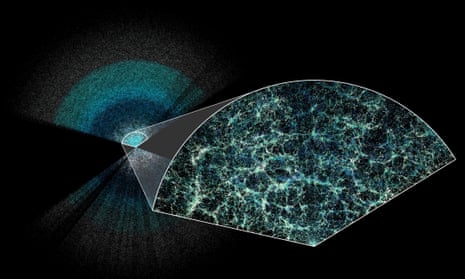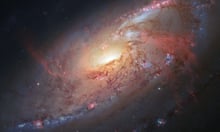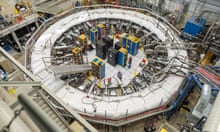The biggest ever 3D map of the universe, featuring more than 6m galaxies, has been revealed by scientists who said it raised questions about the nature of dark energy and the future of the universe.
The map is based on data collected by the Dark Energy Spectroscopic Instrument (Desi) in Arizona and contains three times as many galaxies as previous efforts, with many having their distances measured for the first time.
Researchers said that by using this map, they have been able measure how fast the universe has been expanding at different times in the past with unprecedented accuracy.
The results confirm that the expansion of the universe is speeding up, they added. However, the findings have also raised the tantalising possibility that dark energy – a mysterious, repulsive force that drives the process – is not constant throughout time as has previously been suggested.
Dr Seshadri Nadathur, a co-author of the work and senior research fellow at the University of Portsmouth’s Institute of Cosmology and Gravitation, said: “What we are seeing are some hints that it has actually been changing over time, which is quite exciting because it is not what the standard model of a cosmological constant dark energy would look like.”
Prof Carlos Frenk, from Durham University and a co-author of the research, said that if dark energy was indeed constant in time, the future of the universe was simple: it would expand on and on, for ever. But if the hints found in the map stood up, that would be called into question.
“Now all of that goes out the window and essentially we have to start from scratch, and that means revising our understanding of basic physics, our understanding of the big bang itself, and our understanding of the long-range forecast for the universe,” he said, adding that the new hints left open the possibility that the universe might undergo a “big crunch”.
The research, which has been published in a series of preprints – meaning it has yet to be peer-reviewed – reveals how the team first created the 3D map, then measured patterns in the distribution of galaxies that relate to sound waves that occurred in the early universe, known as baryon acoustic oscillations.
As the size of these patterns is known to be regular, the team was able to calibrate the distances to different galaxies in the map, allowing them to work out how fast the universe has been growing over the last 11bn years, with a precision better than 0.5% over all times, and better than 1% between 8bn and 11bn years ago.
Frenk said the precision itself of the measurements was notable given that galaxies could be billions of light years away, and billions of years old. “It’s mind-boggling that we can measure anything to a precision of 1%, which is precision you get in the laboratory in physics for high-precision measurements,” he said.
Andrew Pontzen, professor of cosmology at University College London and author of the book The Universe in a Box, who was not involved in the work, said Desi was one of a slew of exciting new astronomical surveys cataloguing the night sky, with one of the primary goals being to measure the rate at which our expanding universe has speeded up.
“Like measuring the acceleration of a car, charting the universe’s expansion tells us about the ‘engine’ powering cosmic acceleration. That engine is known as dark energy,” he said.
However, Pontzen noted that our knowledge of how dark energy operates was limited. “The new data, when combined with existing measurements, would seem to contradict the simplest possible explanations for dark energy,” he said.
“At face value, that’s an exciting step forward. But as the team themselves caution, there is a huge amount still to understand about this data and early results should be taken with a healthy grain of salt.”










